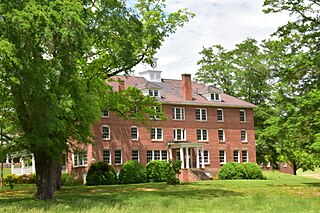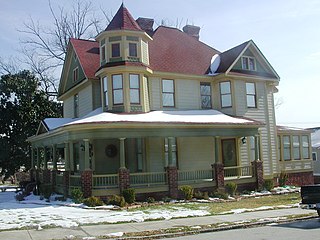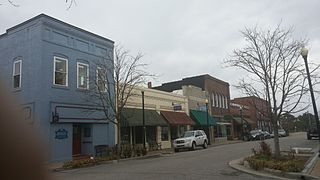
Virginville is a census-designated place in Richmond Township, Berks County, Pennsylvania, United States. It is located at the junction of PA 143 and Crystal Ridge Road, and is approximately seven miles to the south of the borough of Lenhartsville.

Oakwood Historic District is a national historic district located at Hickory, Catawba County, North Carolina. It includes work designed by architects Wheeler & Stearn. It encompasses 50 contributing buildings, 1 contributing site, and 1 contributing structure in an upscale residential section of Hickory. It includes notable examples of Colonial Revival, Bungalow / American Craftsman, and Queen Anne style architecture dating from the 1880s to 1930s. Notable buildings include the Robert E. Simpson House (1922), Walker Lyerly House (1913), Cline-Wilfong House (1912), Abel A. Shuford, II House, Paul A. Setzer House (1927), John H. P. Cilley House (1912), (first) Charles H. Geitner House (1900), Benjamin F. Seagle House, David L. Russell House, Robert W. Stevenson House, Jones W. Shuford House (1907), Dr. Robert T. Hambrick House (1928), Alfred P. Whitener House, and J. Summie Propst House (1881-1883).

Patterson School Historic District is a historic agricultural and Episcopal mission school complex and national historic district located at Legerwood, Caldwell County, North Carolina. The complex includes 13 contributing buildings, 2 contributing sites, and 3 contributing structures. Notable contributing resources include the Colonial Revival-style Palmyra Hall (1927), Sarah Joyce Lenoir Memorial Library, Gard Hall (1920-1921), Headmaster's House (1912), Buffalo Creek Dam (pre-1940), Milk House (1945), two Barns, North Silo (1920s), Chapel of Rest (1918), Jones-Patterson Cemetery, Hugh A. Dobbin House, and Tudor Revival-style Edgar A. Dobbin House (Greystone) (1930s). In 1994 the Episcopal Diocese of Western North Carolina sold the Patterson School property.

Cape Lookout Village Historic District is a national historic district located near Core Banks, Carteret County, North Carolina. It encompasses 20 contributing buildings 1 contributing site, and 6 contributing structures in Cape Lookout Village. The buildings include notable examples of Queen Anne and Bungalow / American Craftsman style architecture. The district includes two government complexes: the Cape Lookout Lighthouse Station and the Cape Lookout Coast Guard Station. In addition, 14 buildings, a long dock, and the circulation network, as well as the landscape in which these lie, compose the district. The buildings include the Life Saving Station (1888) and Boathouse, the Keeper's Quarters (1907), Luther Guthrie House, Gaskill-Guthrie House, Seifert-Davis House, Baker-Holderness House, the Bryant House, and the Carrie Arendell Davis House.
Terrell Historic District is a national historic district located at Terrell, Catawba County, North Carolina. The district encompasses 11 contributing buildings in the crossroads community of Terrell. Most of the buildings date from the late-19th an early-20th century and includes notable examples of Greek Revival and Late Victorian style architecture. Notable buildings include the Connor Store and Post Office, Coleman-Caldwell-Gabriel House, Sherrill-Gabriel House, Rehobeth Methodist Church, Gabriel Cotton Gin (1932), Cotton Storage Building, and Walter Gabriel House.

Fisher Park Historic District is a national historic district in the Fisher Park neighborhood, Greensboro, Guilford County, North Carolina. The district encompasses 541 contributing buildings, 2 contributing sites, and 44 contributing structures in a predominantly residential section of Greensboro. The houses were largely built between the 1900s and 1930s and include notable examples of Queen Anne, Colonial Revival, Gothic Revival, American Foursquare, and Bungalow / American Craftsman-style architecture. Located in the district are the separately listed Dixon-Leftwich-Murphy House, John Marion Galloway House, Julian Price House, and Latham-Baker House. Other notable buildings include the First Presbyterian Church (1928), Holy Trinity Episcopal Church (1922), Gant-McAlister House, and A.J. Schlosser House.

Irving Park Historic District is a national historic district located at Greensboro, Guilford County, North Carolina. The district encompasses 164 contributing buildings, 5 contributing sites, 2 contributing structures, and 2 contributing objects in an affluent planned suburb of Greensboro. It developed around the Greensboro Country Club. The houses were largely built between 1911 and the 1930s and include notable examples of Colonial Revival, Tudor Revival, and Classical Revival-style architecture. Notable buildings include the first Robert Jesse Mebane House, the Cummins A. Mebane House, the Lynn Williamson House, the first J. Spencer Love House, the Aubrey L. Brooks House, Carl I. Carlson House, the Van Wyck Williams House, the Lavlson L. Simmons House, the Albert J. Klutz House, the Irving Park Manor Apartments, McAdoo-Sanders-Tatum House, the Alfred M. Scales House, and the Herman Cone House.

South Greensboro Historic District, also known as the Asheboro Street Historic District, is a national historic district located in the Southside neighborhood, Greensboro, Guilford County, North Carolina. The district encompasses 327 contributing buildings, 1 contributing site, 10 contributing structures, and 1 contributing object in a predominantly residential section of Greensboro. The houses were largely built between the 1870s and the 1930s and include notable examples of Queen Anne, Italianate, American Foursquare, and Bungalow / American Craftsman-style architecture. Notable buildings include the Atkinson House, Hanner House, B.E. Jones House, T. Bernard House, C.O. Younts House, W.S. Witherspoon House, and R. N. Watson House, former Asheboro Street Church, and Nettie Mae Coad Apartments.
Mitchell College Historic District is a national historic district located at Statesville, Iredell County, North Carolina. It encompasses 336 contributing buildings and 1 contributing site associated with Mitchell Community College and the surrounding residential area in Statesville. The district includes notable examples of Greek Revival, Queen Anne, and Classical Revival architecture dated between about 1885 and 1930. Located in the district is the oldest building and separately listed; the Main Building, Mitchell College (1854-1856). Other notable contributing resources are the Fourth Creek Burying Ground, George Anderson House, Friends Meeting House, Broad St. Methodist Church (1907), Congregation Emmanuel Synagogue (1891), McRorie House, Dr. Tom H. Anderson House, Dr. Julius Lowenstein House, Ludwig Ash House, L. N. Mills House (1925), Mills Apartment, R. A. Cooper House (1920), Statesville Woman's Club (1927), and the former Davis Hospital.

Trianon Historic District is a national historic district located at Kinston, Lenoir County, North Carolina. It encompasses 33 contributing buildings and 1 contributing site in a predominantly residential section of Kinston. The buildings include notable examples of Queen Anne, Colonial Revival, and Bungalow / American Craftsman style architecture and date between 1893 and 1930. Notable buildings include the McDaniel-Sutton House (1904), J. C. Raspberry Rental House, Wooten-Black House (1913-1914), George W. Sumrell House, E. T. Turnley House, J. D. Arnold House, and Lizzie Grady House.
Conoho Creek Historic District is a national historic district located near Hassell, Martin County, North Carolina. The district encompasses 77 contributing buildings, 6 contributing site, 5 contributing structures, and 2 contributing objects in a rural agricultural and woodland area of Martin County. They include notable examples of Federal, Georgian, and Greek Revival architecture in buildings dated from the early-19th century through the 1940s. Notable contributing resources include the Outterbridge-Everett Farm, Outterbridge-Briley-Purvis house, the Sherrod-Best-Fleming Farm, the Ballard-Hyman-Thomas Farm, the Ballard-Salsbury-Eubanks Farm, the Cherry-Council House, and the Haislip House.

Villa Place Historic District is a national historic district located at Rocky Mount, Nash County, North Carolina. It encompasses 321 contributing buildings and 1 contributing structure in a residential section of Rocky Mount. The buildings primarily date between about 1900 and 1950, and include notable examples of Queen Anne, Colonial Revival, Classical Revival, and Bungalow / American Craftsman style residential architecture. Located in the district is the separately listed Machaven. Other notable buildings include the W.D. Cochran House, Mills-Watson House, Aladdin Homes Company "kit houses," the James Craig Braswell School (1940), Draine Confectionery, and West End Grocery.

Jackson Historic District is a national historic district located at Jackson, Northampton County, North Carolina. The district encompasses 168 contributing buildings, 2 contributing sites, 1 contributing structure, and 2 contributing objects in the central business district and surrounding residential sections of Jackson. The district developed between about 1825 and 1953 and includes notable examples of Federal and Greek Revival style architecture. Located in the district are the separately listed Amis-Bragg House, Church of the Saviour and Cemetery, and Northampton County Courthouse Square. Other notable contributing resources include Lewis Drug Store (1930), Kennedy's Five Cents to Five Dollars Store, Bank of Northampton (1928), Bowers Hardware Store, Atlas Oil Company Building, Farmer's Cotton Gin Complex, Faison House, Saint Catherine's Hall (1848), Judge Robert Peebles House (1890s), Selden-Boone House, Jackson Baptist Church (1881), and Jackson United Methodist Church (1937).

Seaboard Historic District is a national historic district located at Seaboard, Northampton County, North Carolina. The district encompasses 107 contributing buildings, 1 contributing site, and 4 contributing structures in the central business district and surrounding residential sections of Seaboard. The district developed between about 1874 and 1955 and includes notable examples of Queen Anne and Colonial Revival style architecture. Notable contributing resources include the Edwards Warehouse, Bradley Howell Peanut Drying and Storage Facility, Sidney S. Harris Gas Station, Stephenson-Barbee House, Edwards House, Seaboard United Methodist Church, Bethlehem Baptist Church, and Seaboard School (1927).
Burgaw Historic District is a national historic district located at Burgaw, Pender County, North Carolina. The district encompasses 130 contributing buildings, 1 contributing structure, and 1 contributing object in the central business district and surrounding residential sections of Burgaw. The district developed from the mid-19th to mid-20th century, and includes notable examples of Gothic Revival and Queen Anne style architecture. Located in the district are the separately listed Burgaw Depot and Pender County Courthouse. Other notable contributing buildings include the M. M. Moore House, Murphy-Sasser House, Dr. H. B. Thomas House, Burton-Noel House (1917), Burgaw Presbyterian Church, Macedonia African Methodist Episcopal (AME) Church, Burgaw Methodist Church (1928), the Burgaw Baptist Church (1948), Bank of Pender (1907), Pender County Jail (1924), and R.H. Holland Motor Company Building (1924).

Farmville Historic District is a national historic district located at Farmville, Pitt County, North Carolina. The district encompasses 330 contributing buildings, 1 contributing site, and 2 contributing structures in the central business district and surrounding residential sections of Farmville. It includes buildings dated from about 1860 to 1942 and notable examples of Colonial Revival, Classical Revival, and Queen Anne style architecture. Notable buildings include the James W. May House, Fields-Rasberry House, Dr. David Morrill House, Warren Parker House, Nannie Smith House, First Christian Church (1910), Emmanuel Episcopal Church (1920), St. Elizabeth Catholic Church, Municipal Building (1928) possibly designed by Benton & Benton, Bank of Farmville (1921) designed by Benton & Benton, Pollard Auto Company Building, Paramount Theatre (1930s), J. Y. Monk Tobacco Warehouse, and East Carolina Railway Office and Freight Station.

Columbia Historic District is a national historic district located at Columbia, Tyrrell County, North Carolina. It encompasses 119 contributing buildings, 1 contributing structure, and 1 contributing object in the central business district and surrounding residential sections of Columbia. The district developed between about 1880 and 1944 and includes examples of a variety of popular architecture styles. Located in the district is the separately listed Tyrrell County Courthouse. Other notable buildings include Snell's Inn, Columbia Garage, Columbia Christian Church, McClees-Coffield House, Combs-Hussey House, Frederick L. W. Cohoon House, Columbia Baptist Church (1905), W. J. White Building (1931-1932), Columbian Theatre, Wesley United Methodist Church (1912), St. Andrews Episcopal Church (1909), Tyrrell County Jail, Merchants and Farmers Bank / East Carolina Bank, Tyrrell County Bank, and Columbia Theatre.

Carpenter Historic District is a national historic district located near Cary, Wake County, North Carolina. The districts encompasses 66 contributing buildings, 1 contributing site, and 8 contributing structures in the rural crossroads community of Carpenter. The district developed between about 1895 and 1933, and includes notable examples of Late Victorian and Colonial Revival style architecture. Notable buildings include the Carpenter Farm Supply Company, D. Judson Clark Machine/Garage, Byrd-Ferrell House, Mallie and Cora Butts Farm, A.M. Howard Farm, and Barbee-Williams Farm.

Plymouth Historic District is a national historic district located in Plymouth, Washington County, North Carolina. The district encompasses 258 contributing buildings, 5 contributing sites, and 1 contributing structure in the central business district and surrounding residential sections of Plymouth. It was largely developed between about 1880 and 1930 and includes notable examples of Colonial Revival, Bungalow / American Craftsman and Late Victorian style architecture. Located in the district are the separately listed Latham House, Perry-Spruill House, and Washington County Courthouse. Other notable buildings include the Hornthal-Owens Building, Blount Building, Atlantic Coast Line Railroad Station (1923), Davenport-Davis House, Robert Ward Johnston House (1924), Latham-Brinkley House (1883), Plymouth United Methodist Church and Cemetery, Grace Episcopal Church and Cemetery designed by Richard Upjohn, New Chapel Baptist Church (1924), Agricultural Building (1936-1937) constructed through the Works Progress Administration, Plvmouth Railroad Station (1927), Brinkley Commercial Block (1926), and Clark-Chesson House.
Black Creek Rural Historic District is a national historic district located near Black Creek, Wilson County, North Carolina. It encompasses 68 contributing buildings in a rural area near Black Creek. The district developed after 1787 and includes notable examples of Federal, Georgian, and Greek Revival style architecture. Notable buildings include the Shadrack Dickinson House (1787), Dr. Brooks House, John Woodard House, Stephen Woodard House, and Dr. Stephen Woodard House.



















